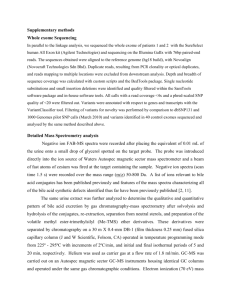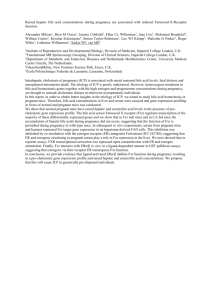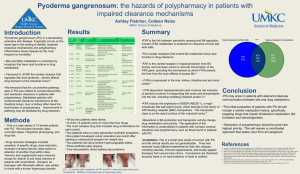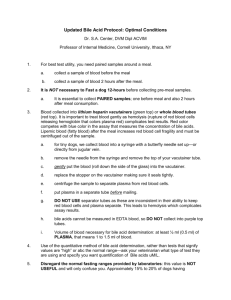Bile-Acid Sequestrants: Glucose-Lowering Mechanisms - HAL
advertisement
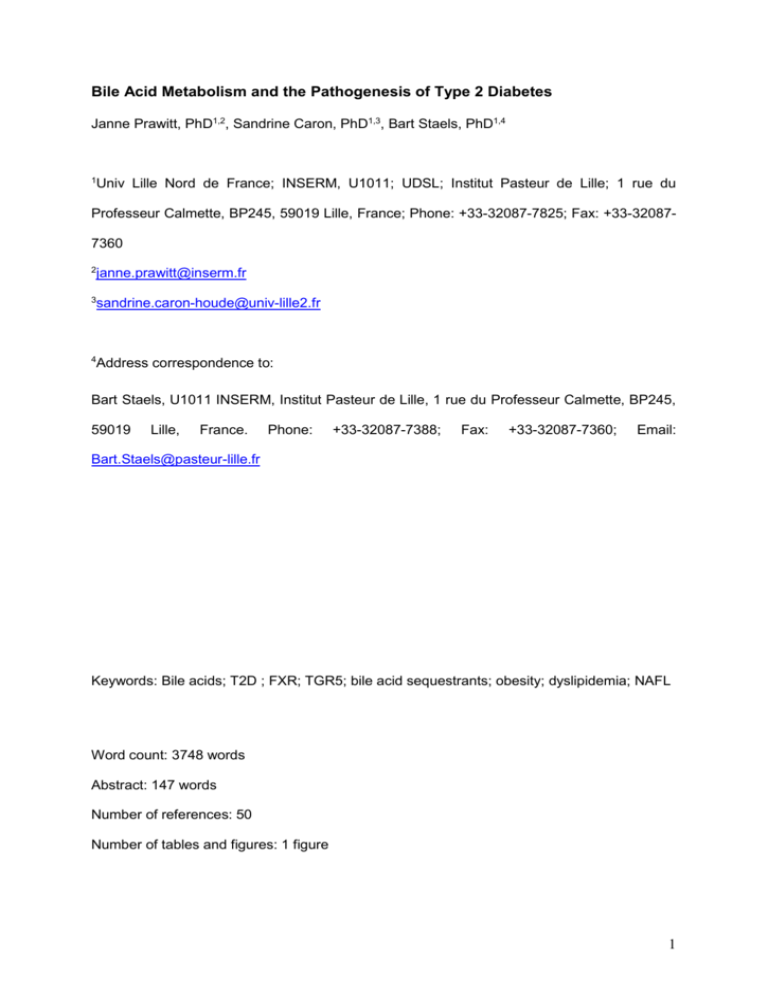
Bile Acid Metabolism and the Pathogenesis of Type 2 Diabetes
Janne Prawitt, PhD1,2, Sandrine Caron, PhD1,3, Bart Staels, PhD1,4
1
Univ Lille Nord de France; INSERM, U1011; UDSL; Institut Pasteur de Lille; 1 rue du
Professeur Calmette, BP245, 59019 Lille, France; Phone: +33-32087-7825; Fax: +33-320877360
2
janne.prawitt@inserm.fr
3
sandrine.caron-houde@univ-lille2.fr
4
Address correspondence to:
Bart Staels, U1011 INSERM, Institut Pasteur de Lille, 1 rue du Professeur Calmette, BP245,
59019
Lille,
France.
Phone:
+33-32087-7388;
Fax:
+33-32087-7360;
Email:
Bart.Staels@pasteur-lille.fr
Keywords: Bile acids; T2D ; FXR; TGR5; bile acid sequestrants; obesity; dyslipidemia; NAFL
Word count: 3748 words
Abstract: 147 words
Number of references: 50
Number of tables and figures: 1 figure
1
Abstract
T2D is a growing health problem world-wide, but the currently available strategies for therapy
and prevention are insufficient. Recent observations indicate that bile acid homeostasis is
altered in T2D. Bile acids are metabolic regulators that act as signaling molecules through
receptor-dependent and -independent pathways. The most prominent signaling molecules
mediating bile acid signaling are the nuclear receptor FXR and the membrane receptor
TGR5. Both are implicated in the regulation of lipid, glucose and energy metabolism.
Dysregulation of these pathways might contribute to the development of T2D and associated
metabolic complications. Interestingly, data from studies with bile acids or bile acid
sequestrants indicate that the manipulation of bile acid homeostasis might be an attractive
approach for T2D therapy. In this review, we summarize the mechanisms of bile-acidmediated metabolic control that might be of relevance in the pathogenesis of T2D.
2
Introduction
Type 2 diabetes (T2D) is characterized by relative insulin deficiency due to the resistance of
target tissues towards insulin action and the concomitant decline of insulin secretion from the
pancreas. T2D pathogenesis includes genetic as well as environmental factors, but despite
extensive research in this field the detailed mechanisms are yet incompletely known. The
development of T2D is commonly associated with obesity and often with hypertension and
dyslipidemia. These latter complications promote the development of cardiovascular disease
which presents the most common mortality linked to T2D [1].
In the past 15 years, a growing body of evidence has shown that bile acid metabolism is
altered in T2D patients and, conversely, that manipulation of the bile acid pool can improve
glycemic control in such patients. Bile acids are increasingly recognized for their function as
metabolic regulators. Via the activation of different signaling pathways, they participate in the
control of bile acid, lipid and glucose metabolism. In this review, we summarize the
mechanisms through which bile acids exert metabolic control and discuss their possible
implication in the pathogenesis of T2D.
Bile acid metabolism
The synthesis and metabolism of bile acids is complex and highly regulated. Bile acids are
synthesized from cholesterol in the liver. Specific transporters located in the basolateral
membrane of the hepatocyte actively secrete bile acids as well as cholesterol and
phospholipids into the bile. The ingestion of a meal triggers the release of bile from the
gallbladder into the intestinal lumen, where bile acids form micelles with dietary lipids and
lipid-soluble vitamins, thereby facilitating their absorption. Specific transporters expressed in
the distal ileum assure the re-absorption of ~95% of bile acids conveying them back to the
liver, while the remaining 5% are excreted in the feces. In humans, the bile acid pool
undergoes this enterohepatic cycle around 12x/day. Even though the bile acid pool size is
3
maintained constant, the flux of bile acids varies during the day. Promoted by the ingestion of
a meal, bile acid flux and plasma bile acid concentrations are highest postprandially [2].
Bile acids consist of a 24-carbon steroid core and a side chain carrying a carboxyl group.
The nature of the bile acid species is determined by the number and position of hydroxyl
groups on the steroid core, forming a hydrophobic and a hydrophilic side of the molecule.
This amphiphatic property is essential for the bile acid’s biological function, i.e. facilitating the
excretion of hydrophobic molecules into the bile and mediating the absorption of dietary lipids
from the intestinal lumen. However, it also turns bile acids into powerful detergents which at
high concentrations may be cytotoxic (toxicity increases with hydrophobicity). For this
reason, the size and composition of the bile acid pool is strictly controlled. Since the
biological activity of a bile acid depends on its chemical structure, the pool composition (and
thus hydrophobicity) may further determine to what extent bile acid signaling pathways are
activated [3].
Bile acids are synthesized in a multiple step process [4]. The liver produces the primary bile
acids cholic acid (CA) and chenodeoxycholic acid (CDCA) in humans, and CA and muricholic
acid (MCA) in mice. The majority of bile acids is formed via the so-called classical pathway
and only a small quantity (in humans estimated at ~6%) via the alternative pathway.
Cholesterol-7α-hydroxylase (CYP7A1) catalyzes the first step of the classical pathway and is
submitted to a negative feedback regulation mediated by bile acids themselves. CYP7A1 is
considered to be the key enzyme of bile acid synthesis, CYP7A1-deficient mice die from liver
failure within three weeks after birth [4]. The key enzymes of the alternative pathway are
sterol 27-hydroxylase (CYP27A1) and 25-hydroxycholesterol-7α-hydroxylase (CYP7B1).
Even though mice deficient for CYP7B1 are able to maintain a normal bile acid pool, a case
of a human newborn has been reported where a CYP7B1 mutation led to severe liver
dysfunction, demonstrating the importance of the alternative pathway in humans [2]. While
CYP7A1 defines the size of the bile acid pool, its composition strongly depends on the
activity of the sterol-12α-hydroxylase (CYP8B1). This enzyme catalyzes the formation of CA
by diverting intermediates from CDCA synthesis (or MCA synthesis in mice), thus defining
4
the CA/CDCA ratio in the pool. As CYP7A1, CYP8B1 is negatively regulated by bile acids [4].
The synthesized primary bile acids are conjugated to glycine or taurine before secretion into
the bile. Once they have reached the intestine, they may undergo deconjugation and
dehydroxylation by bacteria of the gut microflora. The resulting secondary bile acids in
humans are mainly deoxycholic acid (DCA) and lithocholic acid (LCA). During the second
passage through the liver, a small part of the secondary bile acids is again modified by
sulfonation or glucuronidation giving rise to tertiary bile acids.
Bile acids exert negative feedback on their own synthesis as mentioned above, but also on
the expression of transport molecules assuring the enterohepatic cycle. Thus, bile acids
stimulate their basolateral efflux into the bile (via the bile salt export pump BSEP), inhibit their
ileal absorption (via the apical sodium-dependent bile acid transporter ASBT), stimulate their
efflux from the enterocyte into the blood (via the organic solute transporter OST) and inhibit
their apical uptake into the liver (via the sodium taurocholate-cotransporting polypeptide
NTCP). The details of bile acid synthesis and transport regulation have been reviewed in
detail elsewhere [2,3].
Bile acid homeostasis in T2D
Due to their long-known role in the digestion of dietary fat, bile acids have classically been
associated with lipid metabolism. Over the past decades, a limited number of studies has
described alterations of the bile acid pool in T2D patients and animal models. Even though
the available data are not fully consistent, they present a link of bile acid and glucose
homeostasis.
An early study in patients with uncontrolled T2D reported an increase in the bile acid pool
size and fecal bile acid excretion which decreased upon insulin treatment [5]. Consistently,
insulin was found to inhibit the expression of CYP7A1 and CYP27A1 in rat hepatocytes, the
key enzymes of both bile acid synthesis pathways [2]. However, a second study observed no
differences in bile acid synthesis between uncontrolled and insulin-treated diabetic patients
[6]. A recent investigation evaluated bile acid kinetics more systematically in T2D patients [7].
5
Even though no difference was found in the size of the total bile acid pool, the contribution of
specific bile acid species to the pool was altered in T2D. Thus, the pool of the secondary bile
acid DCA was elevated as was the DCA input rate, whereas the CDCA pool decreased [8].
The CA pool was unchanged, even though the CA synthesis rate was elevated in diabetes.
Another study used a metabolomic approach to show lower CA and elevated DCA levels in
plasma of self-reported, controlled diabetic patients compared to controls [9]. Hence, CA
might be increasingly converted into DCA in the gut of patients with T2D. Interestingly,
changes in the gut microflora have lately been associated with the development of metabolic
diseases. This area of research might provide further insights into associated changes of bile
acid metabolism. Despite the increasing interest in the link between bile acid metabolism and
diabetes, the evidence from animal models is still very scarce. In insulin resistant ob/ob mice,
leptin administration diminished the size and further decreased the hydrophobicity of the bile
acid pool, resulting in an enhanced efflux of cholesterol into the bile [10]. Unfortunately,
possible consequences of these alterations on glucose homeostasis were not analyzed.
Herrema et al. investigated bile acid kinetics in more detail in diabetic db/db mice and
observed an elevation of total bile acid pool size and synthesis, due to an increase in the
fractional pool size and synthesis rate of CA [11].
Even though not devoid of discrepancies, the above presented data clearly suggest that
changes in bile acid homeostasis are either a cause or a consequence of the metabolic
disturbances observed during T2D. This raises the question whether the manipulation of bile
acid homeostasis may improve metabolic complications linked to T2D. In this regard, an
interesting study looked at bile acid metabolism in high-fat diet-fed rats that were submitted
to ileal interposition surgery. This operation moves upwards a distal part of the ileum which is
repositioned in the proximal jejunum. The authors found that plasma bile acid levels
increased in operated rats, with a higher ratio of primary to secondary bile acids, and that bile
acid excretion decreased, indicating an early reabsorption which short-circuits the
enterohepatic cycle. Most interestingly, obesity, glucose tolerance and high cholesterol levels
improved subsequent to the operation even though high-fat feeding continued [12]. Similar
6
observations were made in gastric bypass patients who, compared to weight-matched
controls, had increased plasma bile acid levels which inversely correlated with fasting plasma
lipids and postprandial blood glucose [13]. Another recent report confirmed that the increase
of the bile acid pool size, in this case by overexpression of CYP7A1 in mice, protected from
Western diet-induced obesity, insulin resistance and hepatic steatosis [14].
More evidence for a beneficial effect of the modulation of bile acid metabolism comes from
trials in which bile acid sequestrants were administered to T2D patients. These nonabsorbable polymers complex bile acids in the intestinal lumen and thus divert them from the
enterohepatic cycle. Consequently, the bile acid pool composition is modulated [7].
Successfully applied to lower elevated LDL-cholesterol and prevent cardiovascular disease
since a few decades, bile acid sequestrants were found to improve glycemic control in T2D
patients. In patients not adequately controlled by common anti-diabetic therapeutics such as
insulin, sulfonylurea or metformin, the administration of a bile acid sequestrant decreased
plasma glucose and HbA1c concentrations [15]. A pilot study in T2D patients [16] and a
report from diabetic mice [17] suggest that an increase in whole-body insulin sensitivity might
underlie the improvement in glucose homeostasis upon treatment with bile acid
sequestrants. Two other recent investigations found an increase in GLP1 (glucagon-like
peptide 1) secretion from the intestine of sequestrant-treated diabetic rats, which might
mediate the increased responsiveness towards insulin [18,19].
Bile acids as signaling molecules
Over the past decade, several pathways have been identified, which mediate the regulatory
effects of bile acids. The membrane receptor FPR (formyl peptide receptor) was reported to
be activated by CDCA and DCA with an immunosuppressive outcome. The nuclear receptors
PXR (pregnane X receptor) and VDR (vitamin D receptor) were shown to bind the toxic bile
acid LCA and mediate its elimination from the liver and the intestine, providing protection
from cholestasis and colon cancer. The most prominent candidates, however, are the
7
nuclear receptor FXR (farnesoid X receptor) and the G-protein-coupled membrane receptor
TGR5 [2].
FXR
The nuclear receptor FXR is highly expressed in liver and intestine, the main sites of bile acid
metabolism, but also in adipose tissue, pancreas and adrenals [2]. CDCA is most effective in
activating FXR, while LCA, DCA and CA bind with lower affinity and specificity. Upon ligandbinding, FXR acts either as a monomer or forms a heterodimer with RXR (retinoid X
receptor) to subsequently transactivate or repress the expression of genes that contain a
specific FXR response element in their promoter [20]. In addition to the direct regulation of
target gene expression, numerous FXR functions are mediated by the induction of SHP
(short heterodimer protein) which in turn represses target genes in bile acid, lipid and
glucose metabolism [2]. In the intestine, FXR further induces the expression and subsequent
secretion of FGF (fibroblast growth factor) 19 (corresponding to FGF15 in mice), which as a
hormone can transmit the BA-induced signal to specific target tissues. By binding to the FGF
receptor 4 (FGFR4) in the liver, FGF15 inhibits bile acid synthesis via a c-Jun N terminal
kinase (JNK) – mediated pathway [21].
TGR5
The identification of the G protein coupled receptor TGR5 (also Gpbar1, M-Bar, BG37) as a
bile acid receptor [22,23] has opened new insights in the mechanisms of bile acid signaling.
Mainly expressed in the gall bladder, ileum, colon, brown and white adipose tissue, and to a
lesser extent in skeletal muscle, liver and immune cells, TGR5 is activated by nanomolar
concentrations of LCA and TLCA and micromolar concentrations of CA, DCA and CDCA
[15]. After ligand-binding to plasma membrane TGR5, the receptor is internalized, the GαS
subunit released and adenylate cyclase activated. The consecutively formed cAMP can
activate PKA (protein kinase A) or the transcription factor CREB (cAMP response element
8
binding protein), mediating bile acid functions in immunosuppression, energy and glucose
homeostasis [3].
Receptor-independent pathways
Cell signaling networks, e.g. the MAPK pathway, can also be activated by bile acids
independent of the mentioned receptors (reviewed in [24]), but their implication in the control
of metabolic homeostasis still needs to be determined.
Metabolic regulation by bile acids
Based on the variety of bile acid-targeted receptors and signaling pathways, it is obvious that
bile acids exert multiple regulatory functions. Here, we will focus on the role of bile acids in
the regulation of pathways that are affected in T2D and associated metabolic complications
(Figure 1).
Glucose metabolism and insulin sensitivity
T2D is commonly preceded by a state of insulin resistance. In peripheral tissues, insulin
resistance leads to a decreased uptake of glucose from the blood, whereas hepatic insulin
resistance results in enhanced de novo glucose production. Both phenomena contribute to
elevated plasma glucose levels, first in the postprandial and later also in the fasted state.
Bile acids are involved in the regulation of hepatic glucose metabolism by FXR-mediated
pathways. The expression of FXR itself is decreased in rat models of type 1 and T2D, an
effect that could be reversed by the administration of insulin [25]. The evaluation of the
fasting-refeeding transition in FXR-deficient mice revealed the importance of functional FXR
for the maintenance of stable blood glucose concentrations. In the absence of FXR, the
induction of glycolytic (liver pyruvate kinase) and lipogenic genes (fatty acid synthase, acetyl
CoA carboxylase) was accelerated, associated with a transient hypoglycaemia [26]. In
contrast, the induction of glucose-responsive genes was lower upon FXR activation. Via
9
FXR, bile acids further regulate hepatic glucose production by gluconeogenesis. In one set of
studies, FXR activation by CA decreased the expression of the gluconeogenic genes PEPCK
(phosphoenol pyruvate kinase), G6Pase (glucose-6-phosphatase) and FBP1 (fructose-1,6bisphosphatase) [27,28]. In contrast, FXR activation by the synthetic agonist GW4064 was
found to induce the expression of PEPCK [29] in another investigation. In line with this
finding, PEPCK and G6Pase expression were repressed in FXR-deficient mice [26,28].
Despite the controversy of the available data, bile acids clearly impact on the regulation of
hepatic glucose metabolism.
Intact insulin sensitivity is a prerequisite for the maintenance of glucose homeostasis.
Several groups have reported that FXR-deficiency leads to peripheral insulin resistance in
mice with a reduction of glucose disposal and decreased adipose tissue and skeletal muscle
insulin signaling, however they presented conflicting data on the status of the liver [28,30,31].
By contrast, the activation of FXR by GW4064 in insulin-resistant ob/ob mice reduced
hyperinsulinemia and improved glucose tolerance [31]. Another study applying the semisynthetic FXR agonist 6-ethyl-CDCA to diabetic fa/fa rats confirmed the beneficial effect of
FXR activation on insulin resistance in liver and skeletal muscle [32]. In addition to this key
role of FXR in the control of insulin sensitivity, FXR expression has recently been reported to
play a role in the pancreas, where it regulates glucose-induced insulin secretion [33,34] and
protects against lipotoxicity [33], a crucial feature in the development of T2D.
Modulation of the bile acid pool by intestinal sequestration has been shown to improve
insulin resistance in rat models of diabetes by promoting the secretion of GLP1 from
intestinal L-cells [18,19]. The incretin GLP1 is released in response to the ingestion of a meal
and, in addition to controlling appetite and gastrointestinal function, promotes insulin
secretion from the pancreas. This is why GLP1 based strategies are currently being used for
the therapy of T2D. Both studies [18,19] exclude that the observed effect is FXR-dependent.
Most interestingly, recent reports provide evidence that bile acids induce GLP1 secretion by
TGR5-mediated pathways. LCA and DCA TGR5-dependently induced intracellular cAMP
concentrations and GLP1 secretion from intestinal L-cells in vitro [35]. In a second study, the
10
TGR5 agonist oleanolic acid attenuated obesity and improved insulin resistance in mice upon
high-fat diet-feeding [36]. The most detailed investigation has been provided by Thomas et
al. [37]. The authors show that glucose tolerance reduced by TGR5-deficiency and improved
by TGR5 overexpression in high-fat diet-fed mice via increased GLP1 and insulin secretion.
Pharmacological activation of TGR5 by the semi-synthetic agonist INT777 also ameliorated
insulin sensitivity and raised GLP1 secretion in obese mice. The authors proposed that
TGR5 activation raises the intracellular ATP/ADP ratio and enhances calcium influx which
promotes GLP1 secretion. Thus, the TGR5-mediated triggering of GLP1 secretion presents a
powerful mean for bile acids to control glucose homeostasis.
Very few data have demonstrated that receptor-independent pathways account for the
beneficial action of bile acids on glucose homeostasis. The administration of taurineconjugated ursodeoxycholic acid (TUDCA) to genetically obese mice improved insulin
resistance by attenuating endoplasmatic reticulum (ER) stress [38]. A very recent study in
human obese subjects found an increase of insulin sensitivity in liver and muscle, but not
adipose tissue upon TUDCA administration [39]. However, no effect on markers of ER stress
was observed.
Energy metabolism
As mentioned above, visceral obesity is often associated with T2D, which is characterized by
a dysregulation of energy metabolism. It is still under discussion to which extent and by
which mechanisms obesity is causal for the development of insulin resistance and T2D, but
the epidemiological link is clearly established [1].
Even though adipose tissue is not a tissue classically involved in bile acid metabolism, it
expresses FXR [31,40]. In FXR-deficient mice, adipose tissue mass and adipocyte size are
reduced [31,41], indicating a role for FXR in adipocyte biology. Indeed, FXR controls
adipocyte differentiation and function by promoting PPARγ activity and inhibiting the Wnt/βcatenin pathway [40,41]. In the absence of FXR, basal lipolysis is increased whereas
11
lipogenesis is reduced [41]. Further, FXR activation was shown to increase the insulinmediated uptake of glucose [40].
Activation of FXR induces the expression and secretion of FGF19 in the intestine. Fu et al.
have shown that the administration of FGF19 to high-fat diet-fed mice increased energy
expenditure, reversed weight gain and as a consequence improves insulin resistance [42].
Changes of the amount or nature of bile acids passing through the intestine can thus have
strong systemic effects on metabolic regulation by modulating FXR-mediated FGF19
secretion.
The discovery of TGR5 as a bile acid receptor identified another pathway for the bile acidmediated regulation of energy metabolism. The supplementation of a high-fat diet with CA
increased energy expenditure in brown adipose tissue of mice with a beneficial outcome for
obesity and insulin resistance [43]. The authors suggest a TGR5-cAMP-triggered increase in
triiodothyronine due to the activation of deiodinase in brown adipose tissue, resulting in
increased uncoupling. Even though an attractive concept, several facts put the proposed
mechanism into question. Neither the overexpression nor the absence of TGR5 in mice leads
to a difference in body weight and the susceptibility to diet-induced obesity is gender-specific
[44]. Further, thyroid hormones have recently been shown to exert a central rather than
peripheral effect on energy metabolism of brown adipose tissue [45].
Lipid metabolism and NAFL/NASH
Even though the dysregulation of lipid and lipoprotein metabolism is not considered as a
direct cause for T2D, it is strongly associated with obesity, insulin resistance and T2D itself.
Dyslipidemia increases the risk for cardiovascular incidences in T2D. The implication of bile
acids in the regulation of triglyceride and cholesterol metabolism via hepatic FXR became
manifest through the observation of dyslipidemia in FXR-deficient mice [46].
CDCA administration was shown to decrease plasma lipids in hypertriglyceridemic patients,
long before FXR was identified [47]. Watanabe et al. delineated a FXR-SHP-mediated
mechanism which repressed the induction of SREBP1c by LXR and thus reduced
12
lipogenesis and VLDL secretion [48]. Recently, the administration of bile acid sequestrants
was reported to induce lipogenesis dependent of FXR and LXR [11]. The reduction of plasma
triglycerides by FXR activation was further attributed to an increased clearance from the
bloodstream by lipoprotein lipase (LPL). LPL activity is enhanced by the induction of its
activator apolipoprotein CII and the repression of its inhibitor apolipoprotein CIII in the liver
upon FXR activation [2].
Given that bile acids are synthesized from cholesterol, the direct link of these two metabolic
pathways is obvious. Bile acids exert additional control in cholesterol metabolism by
regulating numerous FXR target genes [2]. In vitro, FXR activation induced the expression of
the LDL receptor and repressed its inhibitor PCSK9. However, this mechanism did not seem
to apply in vivo since CDCA administration to patients increased LDL cholesterol levels [20].
The key structural component of HDL, apolipoprotein AI, was reported to be a negative FXR
target gene [2]. Data from mice further proposed that FXR stimulates the uptake of HDL
cholesterol esters via hepatic SRBI induction [46]. Consequently, FXR activation in patients
lowered HDL cholesterol levels [47].
The occurrence of non-alcoholic liver (NAFL) and its progression towards non-alcoholic
steatohepatitis (NASH) in association with insulin resistance and T2D development has been
re-evaluated in the past years. Several studies suggest that NAFLD might be one of the
causal factors for the manifestation of T2D in obese subjects [49]. TUDCA administration
was shown to decrease NAFLD in genetically obese mice [38] and TGR5 activation in dietinduced obesity [37], but no directly-underlying mechanisms were proposed. CDCA and CA
further prevented fructose-induced hepatic steatosis by protecting against the entry of
bacterial endotoxins from the intestine [50]. Several studies have further linked bile acids to
NASH via FXR. FXR-deficient mice displayed marked inflammatory cell infiltration and
increased hepatic collagen content, whereas FXR activation decreased inflammatory cell
infiltration and fibrosis in mice by repression of the fibrotic genes TGF1, α-SMA and TIMP-1
[20].
13
Conclusions
A growing body of evidence acknowledges bile acids as metabolic regulators. By binding to
the nuclear receptor FXR or the membrane receptor TGR5, they participate in the control of
glucose metabolism, insulin sensitivity, energy homeostasis as well as lipid metabolism.
During the pathogenesis of T2D, the composition of the circulating bile acid pool is altered,
probably contributing to the dysregulation of metabolic homeostasis in T2D. The
manipulation of the bile acid pool itself by bile acid substitution or intestinal sequestration, or
bile acid receptors such as FXR and TGR5 present promising strategies to develop
therapeutics for T2D. However, given the diversity of the metabolic pathways controlled by
bile acid signaling, more mechanistic and clinical studies are needed to precipitate the
optimal approach.
14
Acknowledgments
The authors are supported by the EU Grant HEPADIP (N° 018734) and received funding
from Daiichi Sankyo.
Author Disclosure Statement
The authors disclose no conflict of interest.
15
References
1. IDF Diabetes Atlas. Available at http://www.diabetesatlas.org/. Accessed January 2011.
2. Lefebvre P, Cariou B, Lien F et al.: Role of bile acids and bile acid receptors in metabolic
regulation. Physiol Rev 2009, 89:147-191.
3. Thomas C, Pellicciari R, Pruzanski M et al.: Targeting bile-acid signalling for metabolic
diseases. Nat Rev Drug Discov 2008, 7:678-693.
4. Russell DW: The enzymes, regulation, and genetics of bile acid synthesis. Annu Rev
Biochem 2003, 72:137-174.
5. Bennion LJ, Grundy SM: Effects of diabetes mellitus on cholesterol metabolism in man. N
Engl J Med 1977, 296:1365-1371.
6. Abrams JJ, Ginsberg H, Grundy SM: Metabolism of cholesterol and plasma triglycerides in
nonketotic diabetes mellitus. Diabetes 1982, 31:903-910.
7. Brufau G, Stellaard F, Prado K et al.: Improved glycemic control with colesevelam
treatment in patients with type 2 diabetes is not directly associated with changes in bile acid
metabolism. Hepatology 2010, 52:1455-1464.
8. Brufau G, Bahr MJ, Staels B et al.: Plasma bile acids are not associated with energy
metabolism in humans. Nutr Metab 2010, 7:73.
9. Suhre K, Meisinger C, Döring A et al.: Metabolic footprint of diabetes: a multiplatform
metabolomics study in an epidemiological setting. PLoS One 2010, 5:e13953.
10. Hyogo H, Roy S, Paigen B et al.: Leptin promotes biliary cholesterol elimination during
weight loss in ob/ob mice by regulating the enterohepatic circulation of bile salts. J Biol Chem
2002, 277:34117-34124.
11. Herrema H, Meissner M, van Dijk TH et al.: Bile salt sequestration induces hepatic de
novo lipogenesis through farnesoid X receptor- and liver X receptoralpha-controlled
metabolic pathways in mice. Hepatology 2010, 51:806-816.
This study is the first to give detailed insight into bile acid kinetics after sequestration
in diabetic animal models.
16
12. Kohli R, Kirby M, Setchell KDR et al.: Intestinal adaptation after ileal interposition surgery
increases bile acid recycling and protects against obesity-related comorbidities. Am J Physiol
Gastrointest Liver Physiol 2010, 299:G652-60.
This paper elegantly shows that short-circuiting of bile acid cycling might contribute
to the metabolic improvements observed after bariatric surgery.
13. Patti M, Houten SM, Bianco AC et al.: Serum bile acids are higher in humans with prior
gastric bypass: potential contribution to improved glucose and lipid metabolism. Obesity
(Silver Spring) 2009, 17:1671-1677.
14. Li T, Owsley E, Matozel M et al.: Transgenic expression of cholesterol 7alphahydroxylase in the liver prevents high-fat diet-induced obesity and insulin resistance in mice.
Hepatology 2010, 52:678-690.
15. Prawitt J, Staels B: Bile acid sequestrants: glucose-lowering mechanisms. Metab Syndr
Relat Disord 2010, 8 Suppl 1:S3-8.
16. Schwartz SL, Lai Y, Xu J et al.: The effect of colesevelam hydrochloride on insulin
sensitivity and secretion in patients with type 2 diabetes: a pilot study. Metab Syndr Relat
Disord 2010, 8:179-188.
17. Kobayashi M, Ikegami H, Fujisawa T et al.: Prevention and treatment of obesity, insulin
resistance, and diabetes by bile acid-binding resin. Diabetes 2007, 56:239-247.
18. Shang Q, Saumoy M, Holst JJ et al.: Colesevelam improves insulin resistance in a dietinduced obesity (F-DIO) rat model by increasing the release of GLP-1. Am J Physiol
Gastrointest Liver Physiol 2010, 298:G419-24.
19. Chen L, McNulty J, Anderson D et al.: Cholestyramine reverses hyperglycemia and
enhances GLP-1 release in Zucker Diabetic Fatty rats. J Pharmacol Exp Ther 2010,
334:164-170.
20. Prawitt J, Caron S, Staels B: How to modulate FXR activity to treat the Metabolic
Syndrome. Drug Discov Today Dis Mech 2009, 6:e55-e64.
21. Inagaki T, Choi M, Moschetta A et al.: Fibroblast growth factor 15 functions as an
enterohepatic signal to regulate bile acid homeostasis. Cell Metab 2005, 2:217-225.
17
22. Kawamata Y, Fujii R, Hosoya M et al.: A G protein-coupled receptor responsive to bile
acids. J Biol Chem 2003, 278:9435-9440.
23. Maruyama T, Miyamoto Y, Nakamura T et al.: Identification of membrane-type receptor
for bile acids (M-BAR). Biochem Biophys Res Commun 2002, 298:714-719.
24. Nguyen A, Bouscarel B: Bile acids and signal transduction: role in glucose homeostasis.
Cell Signal 2008, 20:2180-2197.
25. Duran-Sandoval D, Mautino G, Martin G et al.: Glucose regulates the expression of the
farnesoid X receptor in liver. Diabetes 2004, 53:890-898.
26. Duran-Sandoval D, Cariou B, Percevault F et al.: The farnesoid X receptor modulates
hepatic carbohydrate metabolism during the fasting-refeeding transition. J Biol Chem 2005,
280:29971-29979.
27. Yamagata K, Daitoku H, Shimamoto Y et al.: Bile acids regulate gluconeogenic gene
expression via small heterodimer partner-mediated repression of hepatocyte nuclear factor 4
and Foxo1. J Biol Chem 2004, 279:23158-23165.
28. Ma K, Saha PK, Chan L et al.: Farnesoid X receptor is essential for normal glucose
homeostasis. J Clin Invest 2006, 116:1102-1109.
29. Stayrook KR, Bramlett KS, Savkur RS et al.: Regulation of carbohydrate metabolism by
the farnesoid X receptor. Endocrinology 2005, 146:984-991.
30. Zhang Y, Lee FY, Barrera G et al.: Activation of the nuclear receptor FXR improves
hyperglycemia and hyperlipidemia in diabetic mice. Proc Natl Acad Sci U S A 2006,
103:1006-1011.
31. Cariou B, van Harmelen K, Duran-Sandoval D et al.: The farnesoid X receptor modulates
adiposity and peripheral insulin sensitivity in mice. J Biol Chem 2006, 281:11039-11049.
32. Cipriani S, Mencarelli A, Palladino G et al.: FXR activation reverses insulin resistance
and lipid abnormalities and protects against liver steatosis in Zucker (fa/fa) obese rats. J
Lipid Res 2010, 51:771-784.
18
33. Popescu IR, Helleboid-Chapman A, Lucas A et al.: The nuclear receptor FXR is
expressed in pancreatic beta-cells and protects human islets from lipotoxicity. FEBS Lett
2010, 584:2845-2851.
34. Renga B, Mencarelli A, Vavassori P et al.: The bile acid sensor FXR regulates insulin
transcription and secretion. Biochim Biophys Acta 2010, 1802:363-372.
35. Katsuma SEA: Bile acids promote glucagon-like peptide-1 secretion through tgr5 in a
murine enteroendocrine cell line stc-1. Biochem Biophys Res Commun 2005, 329:386-390.
36. Sato H, Genet C, Strehle A et al.: Anti-hyperglycemic activity of a TGR5 agonist isolated
from Olea europaea. Biochem Biophys Res Commun 2007, 362:793-798.
37. Thomas C, Gioiello A, Noriega L et al.: TGR5-mediated bile acid sensing controls
glucose homeostasis. Cell Metab 2009, 10:167-177.
This elaborate study is the first to propose a mechanism by which bile acids might
improve glucose homeostasis via TGR5.
38. Ozcan U, Yilmaz E, Ozcan L et al.: Chemical chaperones reduce ER stress and restore
glucose homeostasis in a mouse model of type 2 diabetes. Science 2006, 313:1137-1140.
39. Kars M, Yang L, Gregor MF et al.: Tauroursodeoxycholic Acid may improve liver and
muscle but not adipose tissue insulin sensitivity in obese men and women. Diabetes 2010,
59:1899-1905.
One of the rare investigations of receptor-independent effects of bile acids on insulin
sensitivity in human patients.
40. Rizzo G, Disante M, Mencarelli A et al.: The farnesoid X receptor promotes adipocyte
differentiation and regulates adipose cell function in vivo. Mol Pharmacol 2006, 70:11641173.
41. Abdelkarim M, Caron S, Duhem C et al.: The Farnesoid X Receptor Regulates Adipocyte
Differentiation and Function by Promoting Peroxisome Proliferator-activated Receptor{gamma} and Interfering with the Wnt/{beta}-Catenin Pathways. J Biol Chem 2010,
285:36759-36767.
19
42. Fu L, John LM, Adams SH et al.: Fibroblast growth factor 19 increases metabolic rate
and reverses dietary and leptin-deficient diabetes. Endocrinology 2004, 145:2594-2603.
43. Watanabe M, Houten SM, Mataki C et al.: Bile acids induce energy expenditure by
promoting intracellular thyroid hormone activation. Nature 2006, 439:484-489.
44. Maruyama T, Tanaka K, Suzuki J et al.: Targeted disruption of G protein-coupled bile
acid receptor 1 (Gpbar1/M-Bar) in mice. J Endocrinol 2006, 191:197-205.
45. López M, Varela L, Vázquez MJ et al.: Hypothalamic AMPK and fatty acid metabolism
mediate thyroid regulation of energy balance. Nat Med 2010, 16:1001-1008.
46. Lambert G, Amar MJA, Guo G et al.: The farnesoid X-receptor is an essential regulator of
cholesterol homeostasis. J Biol Chem 2003, 278:2563-2570.
47. Bateson MC, Maclean D, Evans JR et al.: Chenodeoxycholic acid therapy for
hypertriglyceridaemia in men. Br J Clin Pharmacol 1978, 5:249-254.
48. Watanabe M, Houten SM, Wang L et al.: Bile acids lower triglyceride levels via a pathway
involving FXR, SHP, and SREBP-1c. J Clin Invest 2004, 113:1408-1418.
49. Kotronen A, Yki-Järvinen H: Fatty liver: a novel component of the metabolic syndrome.
Arterioscler Thromb Vasc Biol 2008, 28:27-38.
50. Volynets V, Spruss A, Kanuri G et al.: Protective effect of bile acids on the onset of
fructose-induced hepatic steatosis in mice. J Lipid Res 2010, 51:3414-3424.
20
Figure legend
Figure 1: Schematic overview of the functions of bile acids (BA) in the regulation of BA,
energy, glucose and lipid metabolism via FXR- and TGR5-mediated signaling pathways. For
details please see text. GLP1, glucagon-like peptide 1; FGF, fibroblast growth factor; BAT,
brown adipose tissue.
21

